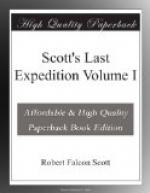From this to the chemical composition of sea water, the total salt about 3.5 per cent, but variable: the proportions of the various salts do not appear to differ, thus the chlorine test detects the salinity quantitatively. Physically plankton life must depend on this salinity and also on temperature, pressure, light, and movement.
(If plankton only inhabits surface waters, then density, temperatures, &c., of surface waters must be the important factors. Why should biologists strive for deeper layers? Why should not deep sea life be maintained by dead vegetable matter?)
Here again the lecturer branched off into descriptions of water bottles, deep sea thermometers, and current-meters, the which I think have already received some notice in this diary. To what depth light may extend is the difficult problem and we had some speculation, especially in the debate on this question. Simpson suggested that laboratory experiment should easily determine. Atkinson suggested growth of bacteria on a scratched plate. The idea seems to be that vegetable life cannot exist without red rays, which probably do not extend beyond 7 feet or so. Against this is an extraordinary recovery of Holosphera Firidis by German expedition from 2000 fathoms; this seems to have been confirmed. Bowers caused much amusement by demanding to know ’If the pycnogs (pycnogonids) were more nearly related to the arachnids (spiders) or crustaceans.’ As a matter of fact a very sensible question, but it caused amusement because of its sudden display of long names. Nelson is an exceedingly capable lecturer; he makes his subject very clear and is never too technical.
Thursday, June 15.—Keen cold wind overcast sky till 5.30 P.M. Spent an idle day.
Jimmy Pigg had an attack of colic in the stable this afternoon. He was taken out and doctored on the floe, which seemed to improve matters, but on return to the stable he was off his feed.
This evening the Soldier tells me he has eaten his food, so I hope all be well again.
Friday, June 16.—Overcast again—little wind but also little moonlight. Jimmy Pigg quite recovered.
Went round the bergs in the afternoon. A great deal of ice has fallen from the irregular ones, showing that a great deal of weathering of bergs goes on during the winter and hence that the life of a berg is very limited, even if it remains in the high latitudes.
To-night Debenham lectured on volcanoes. His matter is very good, but his voice a little monotonous, so that there were signs of slumber in the audience, but all woke up for a warm and amusing discussion succeeding the lecture.
The lecturer first showed a world chart showing distribution of volcanoes, showing general tendency of eruptive explosions to occur in lines. After following these lines in other parts of the world he showed difficulty of finding symmetrical linear distribution near McMurdo Sound. He pointed out incidentally the important inference which could be drawn from the discovery of altered sandstones in the Erebus region. He went to the shapes of volcanoes:




